Transmode talk
Page 8

If you've noticed an error in this article please click here to report it so we can fix it.
ALL ASPECTS of inter-modal international transport were covered at the Transmode '82 conference in Basle, Switzerland last week, writes REG DAWSON.
Kevin Leydon, of the EEC Commission's transport directorate, spoke of the measures in the field of combined transport discussed by the Transport Council of Ministers in Luxembourg (see page 3). He stressed that combined transport should not be seen simply as an escape from licensing problems in international road haulage, but should be promoted in such a way as to increase efficiency.
A plea that own account operators should no longer be barred in certain countries from the use of piggyback services was then made by Dr K. Schone, director of the West German own account organisation. He attributed the ban to hauliers' and railways' fears that they would lose valuable cargo. He disagreed with a delegate who said that own account transport was essentially inefficient because vehicles had usually to travel unladen in one direction.
The first real controversy stemmed from a paper by Martin Marmy, a technical officer with the International Road Transport Union. He outlined the results of a technical study corn missioned by IRU from the independent Battelle Institute in Gen e v a . Even the most economically effective form of combined transport — the swop body — consumed 50 per cent more energy than a "pure" road journey, while in the case of the least energy-efficient form — the "rolling highway" where the entire vehicle, including the tractive unit, is carried on the train — uses five times as much energy as a through journey by road.
In Alpine territory, these differences were scaled down a little because the railway gradient was less steep than road, but even here the swap body used 25 per cent more energy than going by road throughout, while the "rolling highway" used three times as much.
These differences were attributed chiefly to combined transport's low gross weight/payload ratio, but also were caused by the need to divert from the direct route in order to get to and from the piggyback terminal, and the impossibility of making multiple-drop journeys by piggyback. Moreover, the rigidity of the system made it more difficult to obtain return loads.
Mr Marmy went on to plead that energy saving efforts in transport should be concentrated on the harmonisation at a reasonable level of vehicle weights and dimensions at 45 tonnes on five axles for articulated vehicles, and 60 tonnes on seven axles for road trains.
The results of the Battelle' study were challenged from several parts of the floor by various railway interests.










































































